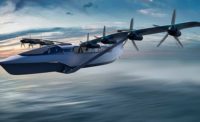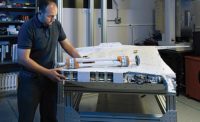Aircraft wings have been assembled the same way for decades. But, engineers at the Massachusetts Institute of Technology (MIT) and NASA have developed a flexible aerostructure that is produced from hundreds of tiny, identical pieces using composite lattice-based cellular materials.
The lightweight wing is comprised of thousands of tiny hollow triangles made up of matchstick- size struts along each edge. The subassemblies are bolted together to form an open, lattice framework that is covered with a thin layer of polymer material.
An active wing morphing design enables it to change shape in flight. Instead of requiring separate movable surfaces, such as ailerons, to control roll and pitch, as conventional wings do, the new assembly system makes it possible to deform the whole wing, or parts of it. “The result is a wing that is much lighter, and thus much more energy efficient, than those with conventional designs made from metal or composites,” claims Nicholas Cramer, a research engineer at NASA Ames Research Center who worked on the project. “Because the structure is composed mostly of empty space, it forms a mechanical metamaterial that combines the structural stiffness of a rubber-like polymer and the extreme lightness and low density of an aerogel.
“Each phase of a flight, such as takeoff and landing, cruising and maneuvering, has its own, different set of optimal wing parameters, so a conventional wing is necessarily a compromise that is not optimized for any of these, and therefore sacrifices efficiency,” adds Cramer. “A wing that is constantly deformable could provide a much better approximation of the best configuration for each stage.”
According to Cramer, it would be possible to include motors and cables to produce the forces needed to deform the wings. However, he and his colleagues have taken this a step further and designed a system that automatically responds to changes in aerodynamic loading conditions by shifting shape.
“We’re able to gain efficiency by matching the shape to the loads at different angles of attack,” says Cramer. “We produced the exact same behavior you would do actively, but we did it passively.
“This is accomplished by the careful design of the relative positions of struts with different amounts of flexibility or stiffness,” explains Cramer. “The wing, or sections of it, bend in specific ways in response to particular kinds of stresses.”
A test version of the wing was manually assembled by a team of MIT graduate students. However, the repetitive process is designed to be easily accomplished by a swarm of small assembly robots. The plastic injection-molded parts are made from polyethylene.
“The resulting lattice has a density of 5.6 kilograms per cubic meter,” says Cramer. “By way of comparison, rubber has a density of about 1,500 kilograms per cubic meter. They have the same stiffness, but ours has less than roughly one-thousandth of the density.
“Because the overall configuration of the wing or other structure is built up from tiny subunits, it really doesn’t matter what the shape is,” Cramer points out. “You can make any geometry you want.
“The fact that most aircraft are the same shape—essentially, a tube with wings—is because of expense,” claims Cramer. “It’s not always the most efficient shape. But, massive investments in design, tooling and production processes make it easier to stay with long-established configurations.
“Studies have shown that an integrated body and wing structure could be far more efficient for many aerospace applications,” adds Cramer. “With this system, those [aircraft] could be easily built, tested, modified and retested.
“The same system could be used to make other structures as well, such as wind turbine blades,” says Cramer. “The ability to do on-site assembly could avoid the problems of transporting ever-longer blades. Similar assemblies are being developed to build space structures and could eventually be useful for bridges and other high-performance structures.”




